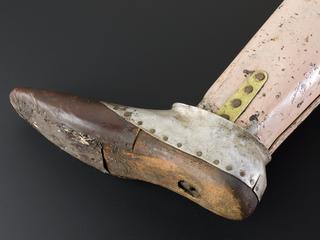
Artificial bootee, Roehampton, England, 1965-1975
One of a pair (right) of stout leather bootees supplied to a child living with thalidomide impairments including limb difference, made by Hanger c.1970. This right bootee is wider than the left. Both bootees show clear signs of wear, internally and externally. However, at some point, a more modern rubber black sole has been added, which shows no signs of wear.
More
Just as each person’s experience of living with thalidomide impairments is different, so is their experience with prosthetic or artificial limbs. This might be due to the attitudes of their families and medical professionals they met. Fittings often did not take into account what children could do with the limbs they had. These leather bootees were intended to be worn when artificial or prosthetic legs were not being used to protect the child’s ankle bones. It is unclear how often these were worn or how many children were offered or used them.
Prosthetic or artificial limbs were in part meant to act as reparations for the impairments that thalidomide had caused. They were frequently used as a way of visually “normalising” the bodies of people living with thalidomide impairments. Many question who these supposed improvements were really meant to help. Some children underwent operations to make the prosthetic limbs fit better which could include amputations. Children had little input into these decisions and the trauma of some of these medical interventions is still felt today, both emotionally and physically.
Thalidomide was a compound found in drugs prescribed to people in the late 1950s and early 1960s. Although today it is associated primarily as a treatment for pregnancy related nausea, it was also prescribed to anyone experiencing symptoms of colds, flu, headaches, anxiety, and insomnia. Thalidomide causes nerve damage in the hands and feet of adults, but when taken in early pregnancy it causes impairments such as limb difference, sight loss, hearing loss, facial paralysis, and impact to internal organs. One tablet is enough to cause significant impairments. Researchers later identified that there was a link between the impairment a person is living with, and which day of the pregnancy thalidomide was taken. UK distributors withdrew the drug in 1961 and a government warning was issued in May 1962.
These bootees protected the exposed feet when artificial lower limbs were not worn. The child could move in or outside the house. Made by prosthetic limb manufacturer Hanger, these stout leather bootees are surprising light despite looking bulky.
- Measurements:
-
overall: 215 mm x 145 mm x 235 mm, 1.12 kg
- Materials:
- leather , plastic (unidentified) and metal (unknown)
- Object Number:
- 1999-577/1
- type:
- bootee and thalidomide
- Image ©
- The Board of Trustees of the Science Museum







